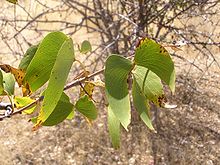Mopani tree
| Mopane | |
|---|---|
 |
|
| Scientific classification | |
| Kingdom: | Plantae |
| (unranked): | Angiosperms |
| (unranked): | Eudicots |
| (unranked): | Rosids |
| Order: | Fabales |
| Family: | Fabaceae |
| Subfamily: | Detarioideae |
| Genus: |
Colophospermum Kirk ex J.Léonard |
| Species: | C. mopane |
| Binomial name | |
|
Colophospermum mopane (Kirk ex Benth.) Kirk ex J.Léonard |
|
 |
|
| Synonyms | |
|
|
Colophospermum mopane, commonly called mopane,mophane, mopani,balsam tree,butterfly tree, or turpentine tree, is a tree in the legume family (Fabaceae), that grows in hot, dry, low-lying areas, 200 to 1,150 metres (660 to 3,770 ft) in elevation, in the far northern parts of southern Africa. The tree only occurs in Africa and is the only species in genus Colophospermum. Its distinctive butterfly-shaped (bifoliate) leaf and thin seed pod make it easy to identify. In terms of human use it is, together with camel thorn and leadwood, one of the three regionally important firewood trees.
It is native to Botswana, South Africa, Zimbabwe, Mozambique, Zambia, Namibia, Angola and Malawi. It is found growing in alkaline (high lime content) soils which are shallow and not well drained. It also grows in alluvial soils (soil deposited by rivers). In small portions of South Africa and larger adjacent areas of Botswana and Zimbabwe, the trees tend to vary between 4 and 18 m (13 and 59 ft), often called "mopane scrub" (shrub) but also sometimes taller and forming woodland, where further north the trees are taller and form tall woodlands referred to as cathedral mopane. This tree does not grow well outside hot, frost-free areas with summer rainfall.
Mopane wood is one of southern Africa's heaviest and is difficult to work because of its hardness. However, this also makes it termite resistant. For this reason it has long been used for building houses and fences, as railway sleepers and as pit props. The termite-resistance and rich, reddish colouring also make it popular for flooring. Outside Africa, mopane is gaining popularity as a heavy, decorative wood, its uses including aquarium ornaments, bases for lamps or sculptures, and garden accents.
...
Wikipedia
